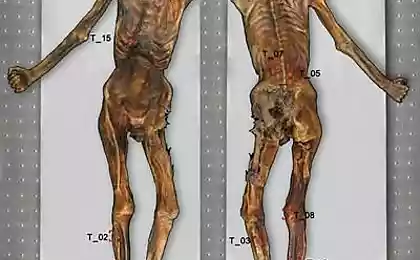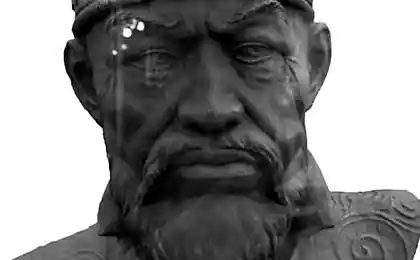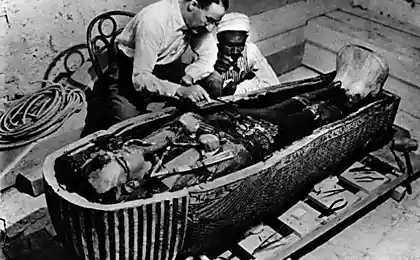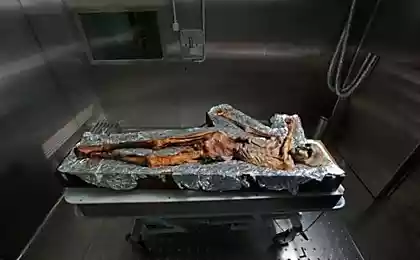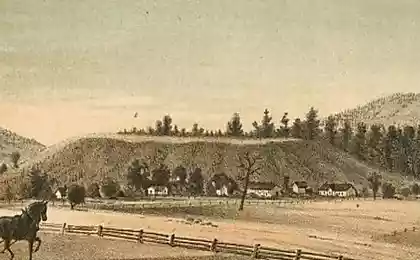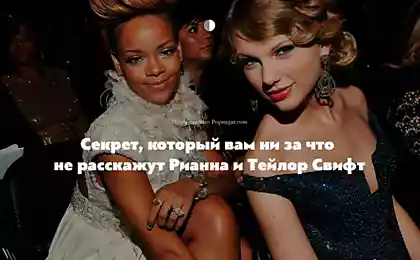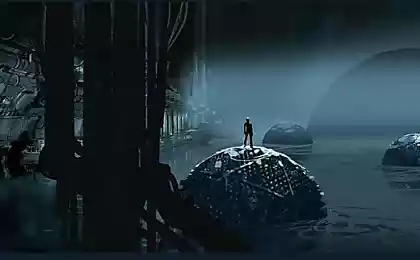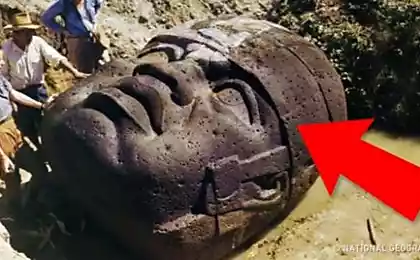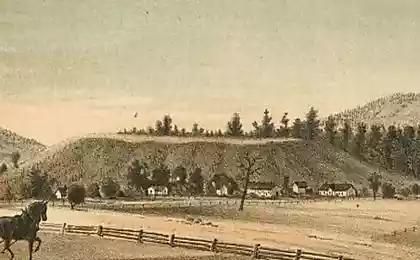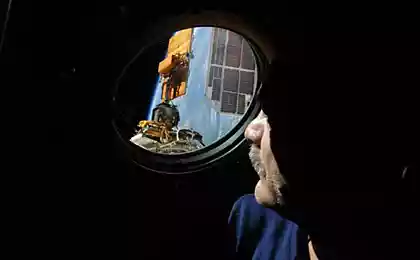588
About ECR
230 thousand. Curious visit annually Archaeological Museum in Bolzano (Italy). First of all, because of the world's most famous mumii- in the museum you can see the frozen remains of 5,300-year-old Ötzi.
Boltsantsy avoid the term "artifact". They realize that Etsi- people. A person who, on the one hand is a huge scientific interest, but on the other, has been for 20 years, attracts the masses with its unusual tattoos, the fact of death and the mysteries of life.
To erase the boundaries between scientific research and the public interest, it was decided mummy put on public display, but in a specially designated chamber. To it belong two freezers, as well as facilities for research and for decontamination. On 3 floors of the museum you can learn the history of finding an ice mummies, the latest information on the living conditions of Ötzi, the myths and legends about him.
7 photo
via epoc.de
1. mummy is in a sealed chamber, at -6 ° C and 98% humidity. Respecting the rest of the ice man, the camera located in the most remote and darkened areas of the museum.

2. Here, in the mountainous massif of the Ötztal Alps, September 19, 1991, two German tourists found a corpse of the late Neolithic period. It is first they thought that came across the corpse of a climber killed in these places a few years ago. Very quickly focused their attention on the discovery, archaeologists and a few days later, it was already a world sensation, and not the victim of an accident.
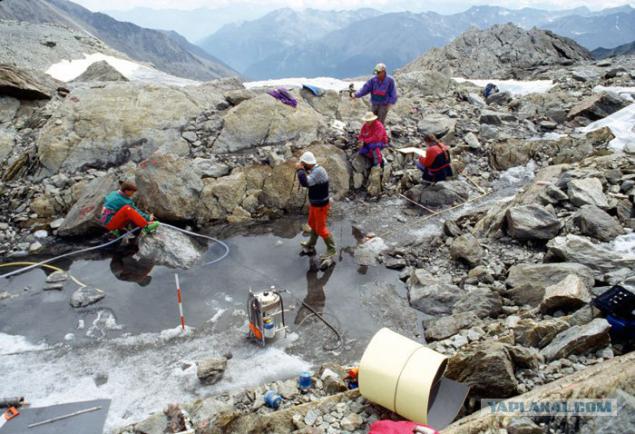
3. 10 years later, in 2001, scientists found on the body of the mummy, in the left shoulder joint, an arrowhead made of flint. The tip did not touch the vital organs, but fell into a large blood vessel. Before Ötzi, bleeding, cold, he was involved in a fierce struggle. This is also evidenced by injuries on the hands and head. Perhaps he was trying to flee when he was overtaken by the boom of the enemy.
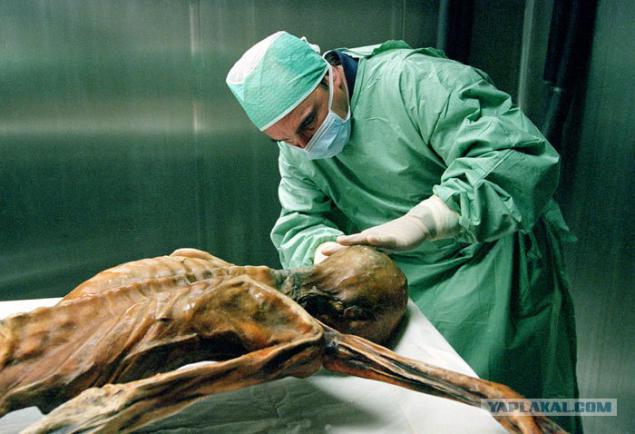
4. On Ötzi's body was found more than 50 tattoos. Other than today, the tattoo needle is not applied, and cut into the skin with a knife. Before we had time to heal the wound, it is rubbed charcoal. It is noteworthy that all the drawings were pinned in places that begin with age causing large in the area of the lumbar vertebrae, for example, on their knees or Achilles tendon.

5. Today, most scientists agree that tattoos on the body of the mummy were not symbolic and ritual importance, and have an analgesic effect. Interestingly, the place tattoos completely correspond to the basic acupuncture points of traditional Chinese medicine, which appeared, however, only 2 thousand. Years later.
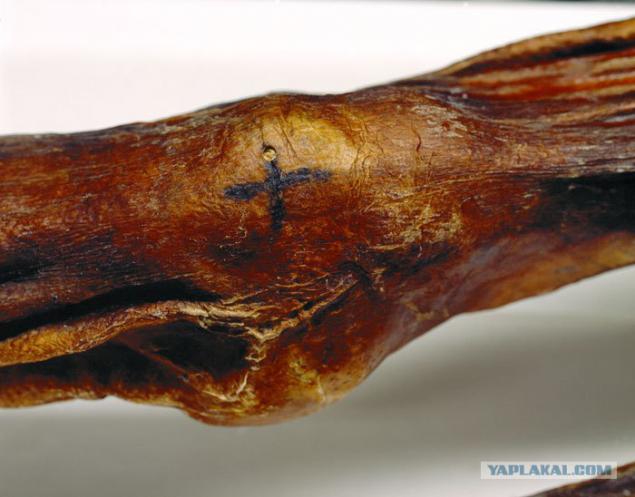
6. In the quiver, along with roughly hewn wooden sticks, were two arrows. About 90 cm long, they were made of viburnum branches. Flint glued using birch tar. On the other hand applied to stabilize the tail boom in-flight.
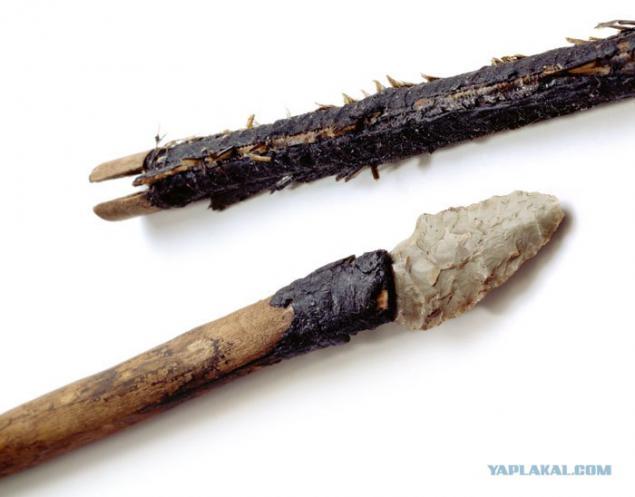
7. Dagger with a length of about 13 cm, consists of a three-cornered blade carved from flint, and the handle of ash wood. The blade goes deep into the forked handle and firmly fixed tendons kakogo- animal. To arms attached scrip, woven from linden bast.
The exhibits can be seen at the museum from March 1, 2011 to January 15, 2012.
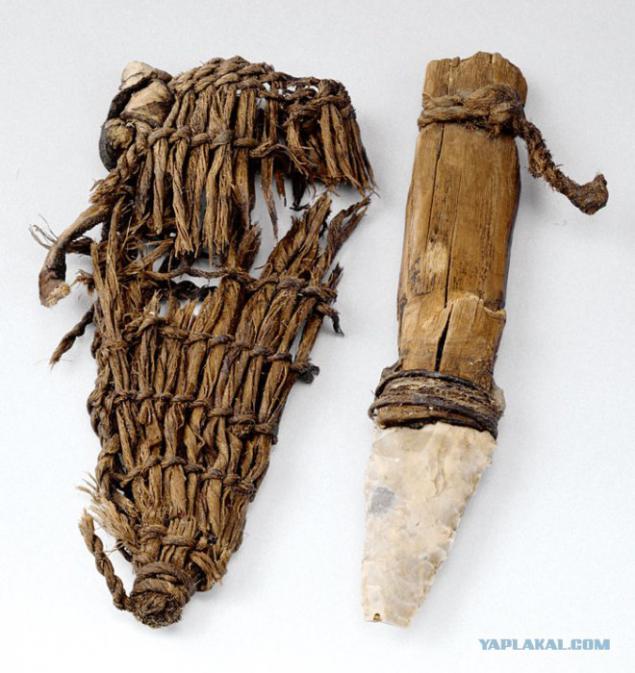
Source:
Boltsantsy avoid the term "artifact". They realize that Etsi- people. A person who, on the one hand is a huge scientific interest, but on the other, has been for 20 years, attracts the masses with its unusual tattoos, the fact of death and the mysteries of life.
To erase the boundaries between scientific research and the public interest, it was decided mummy put on public display, but in a specially designated chamber. To it belong two freezers, as well as facilities for research and for decontamination. On 3 floors of the museum you can learn the history of finding an ice mummies, the latest information on the living conditions of Ötzi, the myths and legends about him.
7 photo
via epoc.de
1. mummy is in a sealed chamber, at -6 ° C and 98% humidity. Respecting the rest of the ice man, the camera located in the most remote and darkened areas of the museum.

2. Here, in the mountainous massif of the Ötztal Alps, September 19, 1991, two German tourists found a corpse of the late Neolithic period. It is first they thought that came across the corpse of a climber killed in these places a few years ago. Very quickly focused their attention on the discovery, archaeologists and a few days later, it was already a world sensation, and not the victim of an accident.

3. 10 years later, in 2001, scientists found on the body of the mummy, in the left shoulder joint, an arrowhead made of flint. The tip did not touch the vital organs, but fell into a large blood vessel. Before Ötzi, bleeding, cold, he was involved in a fierce struggle. This is also evidenced by injuries on the hands and head. Perhaps he was trying to flee when he was overtaken by the boom of the enemy.

4. On Ötzi's body was found more than 50 tattoos. Other than today, the tattoo needle is not applied, and cut into the skin with a knife. Before we had time to heal the wound, it is rubbed charcoal. It is noteworthy that all the drawings were pinned in places that begin with age causing large in the area of the lumbar vertebrae, for example, on their knees or Achilles tendon.

5. Today, most scientists agree that tattoos on the body of the mummy were not symbolic and ritual importance, and have an analgesic effect. Interestingly, the place tattoos completely correspond to the basic acupuncture points of traditional Chinese medicine, which appeared, however, only 2 thousand. Years later.

6. In the quiver, along with roughly hewn wooden sticks, were two arrows. About 90 cm long, they were made of viburnum branches. Flint glued using birch tar. On the other hand applied to stabilize the tail boom in-flight.

7. Dagger with a length of about 13 cm, consists of a three-cornered blade carved from flint, and the handle of ash wood. The blade goes deep into the forked handle and firmly fixed tendons kakogo- animal. To arms attached scrip, woven from linden bast.
The exhibits can be seen at the museum from March 1, 2011 to January 15, 2012.

Source:

